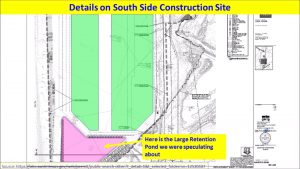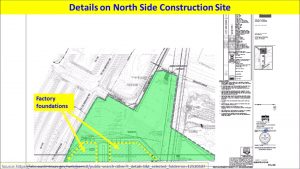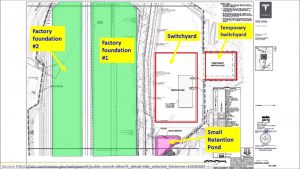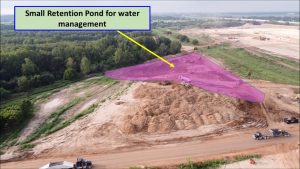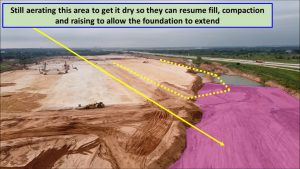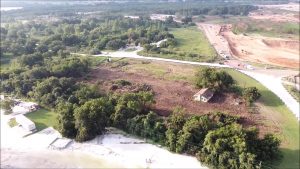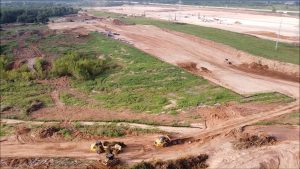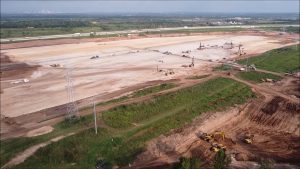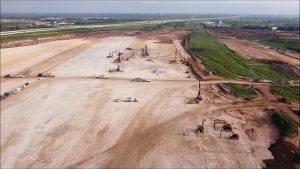

News
Tesla Gigafactory Texas construction plans revealed in permit documents
Tesla’s construction plans for its newest Gigafactory in Texas were recently revealed on the City of Austin’s official website. In documents filed during the permit process, the shape of the factory itself and specific locations for several landscape features were confirmed. This new information provides a solid basis for comparison to track the step-by-step building process of the future Cybertruck and Semi factory location.
Tesla owner and enthusiast Joe Tegtmeyer has been publishing drone footage of Giga Texas progress updates on his YouTube channel since the first construction vehicles entered the site, and these latest permit images and annotations come courtesy of those efforts. In a video uploaded on September 15th, Tegtmeyer added overlays to drone footage to help viewers identify the features indicated in Tesla’s permit documents. Of particular note were the outlines of the Gigafactory foundation on the site, two switchyards (one temporary), and several water retention ponds to control rainfall that’s typical for the Austin area.
In the flyover update itself, Gigafactory construction does appear to continue its fast-paced progress as expected. A new clearing revealed an old house that will most likely be demolished, and as Tegtmeyer detailed in the video’s notes, it looks as though GeoPier work is being done in the northern part of the site. Efforts to fill in and level where the main factory foundation will go were also underway in the central parts of that area, and construction activity looked to be still drying and filling out the northwestern corner of the main building region where the building’s shape isn’t quite complete.
- Tesla Gigafactory Texas Construction Update – 9/16/2020 (Credit: Joe Tegtmeyer/YouTuber
- Tesla Gigafactory Texas Construction Update – 9/16/2020 (Credit: Joe Tegtmeyer/YouTuber
- Tesla Gigafactory Texas Construction Update – 9/16/2020 (Credit: Joe Tegtmeyer/YouTuber
- Tesla Gigafactory Texas Construction Update – 9/16/2020 (Credit: Joe Tegtmeyer/YouTube)
- Tesla Gigafactory Texas Construction Update – 9/16/2020 (Credit: Joe Tegtmeyer/YouTube)
- Tesla Gigafactory Texas Construction Update – 9/16/2020 (Credit: Joe Tegtmeyer/YouTuber
In related news, Tesla presented a rough time frame for the upcoming Cybertruck and Semi factory location in its “Travis County Colorado River Project Partner Pre‐Qualification Presentation,” which is another document recently published on the City of Austin’s official page. Giga Texas estimates a first “dry-in” by December 30th of this year, and a first “substantial completion” is scheduled for May 2021. If completed as planned, this ambitious schedule will be an amazing feat for such a mammoth-sized construction project. Given that work is being done nearly 24/7 and without much regard for weather, the efforts are the very least well-directed.
- Tesla Gigafactory Texas Construction Update – 9/16/2020 (Credit: Joe Tegtmeyer/YouTube)
- Tesla Gigafactory Texas Construction Update – 9/16/2020 (Credit: Joe Tegtmeyer/YouTube)
- Tesla Gigafactory Texas Construction Update – 9/16/2020 (Credit: Joe Tegtmeyer/YouTube)
- Tesla Gigafactory Texas Construction Update – 9/16/2020 (Credit: Joe Tegtmeyer/YouTuber
The Tesla Semi and Cybertruck are not the only vehicles expected to be produced at the electric car manufacturer’s Gigafactory Texas complex. During this year’s second-quarter earnings call, CEO Elon Musk stated that the upcoming facility would also be producing the Model 3 sedan and its sibling, the Model Y crossover. Musk additionally detailed that vehicles produced in Texas would be slotted for customers residing in the eastern United States.
Tesla’s newest Gigafactory in Texas also has the potential to house the company’s next-generation vehicle production systems, given the technology developments in play for the Semi and Cybertruck. For example, the electric pickup will not have a stamping area due to the vehicle’s use of steel and XY design, so a unique production line is expected there. Additionally, the Model Y line will likely utilize the company’s “Giga Press,” a huge machine that could give the all-electric crossover a rear body comprised of a single piece.
You can watch Joe Tegtmeyer’s full September 15th Giga Texas update below:

News
Tesla starts showing how FSD will change lives in Europe
Local officials tested the system on narrow country roads and were impressed by FSD’s smooth, human-like driving, with some calling the service a game-changer for everyday life in areas that are far from urban centers.

Tesla has launched Europe’s first public shuttle service using Full Self-Driving (Supervised) in the rural Eifelkreis Bitburg-Prüm region of Germany, demonstrating how the technology can restore independence and mobility for people who struggle with limited transport options.
Local officials tested the system on narrow country roads and were impressed by FSD’s smooth, human-like driving, with some calling the service a game-changer for everyday life in areas that are far from urban centers.
Officials see real impact on rural residents
Arzfeld Mayor Johannes Kuhl and District Administrator Andreas Kruppert personally tested the Tesla shuttle service. This allowed them to see just how well FSD navigated winding lanes and rural roads confidently. Kruppert said, “Autonomous driving sounds like science fiction to many, but we simply see here that it works totally well in rural regions too.” Kuhl, for his part, also noted that FSD “feels like a very experienced driver.”
The pilot complements the area’s “Citizen Bus” program, which provides on-demand rides for elderly residents who can no longer drive themselves. Tesla Europe shared a video of a demonstration of the service, highlighting how FSD gives people their freedom back, even in places where public transport is not as prevalent.
What the Ministry for Economic Affairs and Transport says
Rhineland-Palatinate’s Minister Daniela Schmitt supported the project, praising the collaboration that made this “first of its kind in Europe” possible. As per the ministry, the rural rollout for the service shows FSD’s potential beyond major cities, and it delivers tangible benefits like grocery runs, doctor visits, and social connections for isolated residents.
“Reliable and flexible mobility is especially vital in rural areas. With the launch of a shuttle service using self-driving vehicles (FSD supervised) by Tesla in the Eifelkreis Bitburg-Prüm, an innovative pilot project is now getting underway that complements local community bus services. It is the first project of its kind in Europe.
“The result is a real gain for rural mobility: greater accessibility, more flexibility and tangible benefits for everyday life. A strong signal for innovation, cooperation and future-oriented mobility beyond urban centers,” the ministry wrote in a LinkedIn post.
News
Tesla China quietly posts Robotaxi-related job listing
Tesla China is currently seeking a Low Voltage Electrical Engineer to work on circuit board design for the company’s autonomous vehicles.

Tesla has posted a new job listing in Shanghai explicitly tied to its Robotaxi program, fueling speculation that the company is preparing to launch its dedicated autonomous ride-hailing service in China.
As noted in the listing, Tesla China is currently seeking a Low Voltage Electrical Engineer to work on circuit board design for the company’s autonomous vehicles.
Robotaxi-specific role
The listing, which was shared on social media platform X by industry watcher @tslaming, suggested that Tesla China is looking to fill the role urgently. The job listing itself specifically mentions that the person hired for the role will be working on the Low Voltage Hardware team, which would design the circuit boards that would serve as the nervous system of the Robotaxi.
Key tasks for the role, as indicated in the job listing, include collaboration with PCB layout, firmware, mechanical, program management, and validation teams, among other responsibilities. The role is based in Shanghai.
China Robotaxi launch
China represents a massive potential market for robotaxis, with its dense urban centers and supportive policies in select cities. Tesla has limited permission to roll out FSD in the country, though despite this, its vehicles have been hailed as among the best in the market when it comes to autonomous features. So far, at least, it appears that China supports Tesla’s FSD and Robotaxi rollout.
This was hinted at in November, when Tesla brought the Cybercab to the 8th China International Import Expo (CIIE) in Shanghai, marking the first time that the autonomous two-seater was brought to the Asia-Pacific region. The vehicle, despite not having a release date in China, received a significant amount of interest among the event’s attendees.
Elon Musk
Elon Musk and Tesla AI Director share insights after empty driver seat Robotaxi rides
The executives’ unoccupied tests hint at the rapid progress of Tesla’s unsupervised Robotaxi efforts.

Tesla CEO Elon Musk and AI Director Ashok Elluswamy celebrated Christmas Eve by sharing personal experiences with Robotaxi vehicles that had no safety monitor or occupant in the driver’s seat. Musk described the system’s “perfect driving” around Austin, while Elluswamy posted video from the back seat, calling it “an amazing experience.”
The executives’ unoccupied tests hint at the rapid progress of Tesla’s unsupervised Robotaxi efforts.
Elon and Ashok’s firsthand Robotaxi insights
Prior to Musk and the Tesla AI Director’s posts, sightings of unmanned Teslas navigating public roads were widely shared on social media. One such vehicle was spotted in Austin, Texas, which Elon Musk acknowleged by stating that “Testing is underway with no occupants in the car.”
Based on his Christmas Eve post, Musk seemed to have tested an unmanned Tesla himself. “A Tesla with no safety monitor in the car and me sitting in the passenger seat took me all around Austin on Sunday with perfect driving,” Musk wrote in his post.
Elluswamy responded with a 2-minute video showing himself in the rear of an unmanned Tesla. The video featured the vehicle’s empty front seats, as well as its smooth handling through real-world traffic. He captioned his video with the words, “It’s an amazing experience!”
Towards Unsupervised operations
During an xAI Hackathon earlier this month, Elon Musk mentioned that Tesla owed be removing Safety Monitors from its Robotaxis in Austin in just three weeks. “Unsupervised is pretty much solved at this point. So there will be Tesla Robotaxis operating in Austin with no one in them. Not even anyone in the passenger seat in about three weeks,” he said. Musk echoed similar estimates at the 2025 Annual Shareholder Meeting and the Q3 2025 earnings call.
Considering the insights that were posted Musk and Elluswamy, it does appear that Tesla is working hard towards operating its Robotaxis with no safety monitors. This is quite impressive considering that the service was launched just earlier this year.
